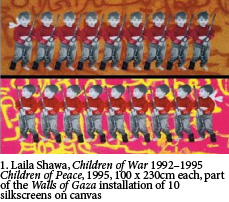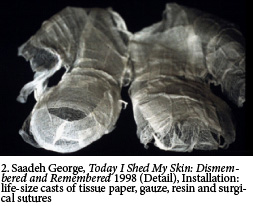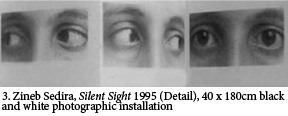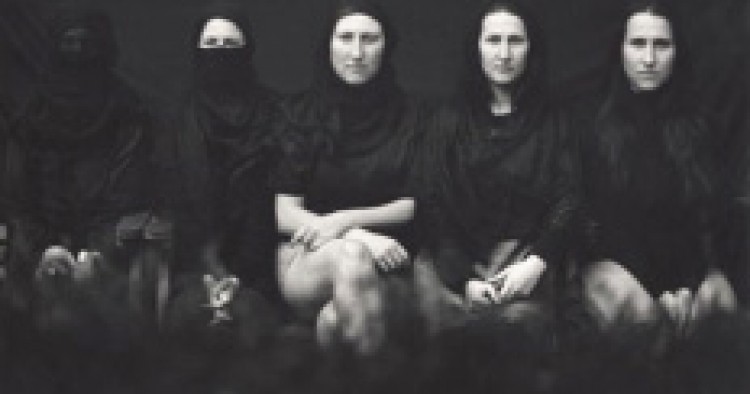Originally posted July 2010
A decade has passed since the first major touring exhibition of contemporary Arab women’s art took place in Britain, curated by Siumee Helen Keelan and accompanied by the publication entitled Contemporary Arab Women’s Art: Dialogues of the Present. The overall project was developed in partnership with the Women’s Art Library in London at a time when most Western non-Arab audiences knew little about contemporary Arab art and even less about contemporary Arab women’s art practice. Focusing predominately on work produced in the 1990s, it foregrounded the rich and diverse creative practices of five generations of Arab women artists working and living in the vastly different geographies of the Middle East, North Africa, and the diaspora of London.
In total, the exhibition included the work of 18 artists from Algeria, Iraq, Kuwait, Lebanon, Morocco, Palestine, Sudan, Syria, and the United Arab Emirates (UAE). Working within different geographic areas and informed by specific and differently-accented colonial and/or postcolonial histories and experiences, they recognized their work as contributing to a multifaceted and multi-sited dialogue on contemporary Arab women’s subjectivities. In this context, this essay focuses on the creative practices of the artists included in Dialogues of the Present who live and work in the Arab diaspora of London. Here, I explore the diversity of their practices, referring to specific examples of their work and the differing ways in which they reconfigure, image, and negotiate their multiple positionings as Arab women and artists working across at least two cultures, while refusing to be defined by race or gender.
All of the artists discussed here relocated to London between the late 1970s and the mid-1990s — some as the result of voluntary or involuntary exile and others for professional reasons. The three generations extend from the painter Laila Shawa (born in 1940 under the British Mandate in Gaza) who trained in Cairo and Rome and the artist and singer Houria Niati (born 1948 in French-occupied Algeria) who moved to London in 1977, to the younger artists Jananne Al-Ani (born 1966 in Iraq) and Zineb Sedira (born 1963 in Paris), who both trained in London in the 1990s.
The majority relocated in the 1980s in the wake of the civil war in Lebanon and the Iran-Iraq war. In addition to Shawa and Al-Ani mentioned above, these include the painter Batool Al-Fekaiki (born in Iraq in 1952) and trained in Baghdad; Maysaloun Faraj (born 1955 in the United States and educated in Baghdad from 1968), and the two Lebanese artists, Saadeh George (born 1950) and the late Mai Ghoussoub (1952-2007). The illustrator Sabiha Khemir (born in 1959 in Tunisia) also moved to London in the early 1980s to study Islamic art, subsequently establishing her career as a writer, scholar, and artist.
To speak of “Contemporary Arab women’s art” in the late 1990s was a strategic intervention to foreground a rich range of practices that simultaneously challenged the monolithic and stereotypical media representations of Arab women, who frequently were portrayed as passive, anonymous figures removed from the sphere of cultural production and from its histories. The 1980s and 1990s was a period of intense reevaluation of “Britishness,” as a generation of descendants of post-war immigrants from its former colonies challenged various forms of social and cultural exclusion based upon race and gender. New concepts of the diaspora emerged which were of particular relevance to the diverse practices of Arab artists engaged with multiple belongings, highlighting the effects of war and the refusal to fix female Arab identities.
For instance, Laila Shawa’s large-scale silkscreen prints Children of Peace and Children of War from the Walls of Gaza series, initiated in 1992, are powerful images that foreground the far-reaching effects of war on generations of Palestinian children. Using the media-generated visual language associated with American pop art, the repeated silk-screened image of the young boy on the gaudy colored surface presents an endless cycle of victim and aggressor. In the background are Shawa’s photographs taken over several years of the graffiti appearing on the walls of Gaza — a differently- positioned form of communication. (Image 1)
Saddeh George’s installation directly refers to her experiences as a doctor in Beirut during the civil war. Today I Shed My Skin: Dismembered and Remembered (1998) consists of life-size casts of George’s body, suspended in the gallery space. As acts of embodied memory, the translucent casts of her gendered body literally hold the traces of her past in Lebanon. Equally, as fragile, discarded skins, they refuse the fixing of identity by religion, race, or ethnicity. (Image 2)
to her experiences as a doctor in Beirut during the civil war. Today I Shed My Skin: Dismembered and Remembered (1998) consists of life-size casts of George’s body, suspended in the gallery space. As acts of embodied memory, the translucent casts of her gendered body literally hold the traces of her past in Lebanon. Equally, as fragile, discarded skins, they refuse the fixing of identity by religion, race, or ethnicity. (Image 2)
Mai Ghoussoub’s installation Diva (1994) offers a parallel, gendered response to war.  Supposedly attempting to recreate an over-life-size sculpture of the female Egyptian singer Um Kulthum as a homage to cosmopolitan Beirut, Ghoussoub represents the iconic signs associated with the singer — the glasses, the beads, the scarf — alongside the disembodied sounds of her songs. The materialized body of the female is notably absent.
Supposedly attempting to recreate an over-life-size sculpture of the female Egyptian singer Um Kulthum as a homage to cosmopolitan Beirut, Ghoussoub represents the iconic signs associated with the singer — the glasses, the beads, the scarf — alongside the disembodied sounds of her songs. The materialized body of the female is notably absent.
Responding to the Iran-Iraq war, the subsequent sanctions on Iraq, and her forced exile in London, Batool Al-Fekaiki’s oil paintings employ a different approach. Evoking her memories of Baghdad, recreating glimpses of its ancient buildings, her inscriptions in Closed City (1997) mark a different order of regenerative time symbolized by the female mythological figure of Ishtar.
Houria Niati’s installation, Ziryab ... Another Story (1998) a series of hanging scroll paintings, a floor mosaic of drawings, a wall montage, alongside the text of Niati’s Ziryab songs, brings together forms and motifs informed by both European and Arabic art and architecture. A tribute to Ziryab Iba Nafi, the 9th century Middle Eastern composer living in exile in Cordoba, Spain, then part of the Arab-Islamic empire, the installation points directly to other histories of Arab culture and to forms of music and song that travelled to Algeria and that survived colonization, war, and the strictures of Islamic Fundamentalism in the late 1990s. (See Cover)
Questions related to monolithic representations of Arab women are further addressed by the lens-based work of Jananne Al-Ani and Zineb Sedira. Al-Ani’s early photographic installations and video works represent her three sisters, herself, and her mother, all of whom moved to Britain in 1980 from Iraq, where Al-Ani was born and brought up. In the large black and white photograph, Untitled (Veiling Project), the direct gazes of the row of five seated women are depicted in various states of veiling, unveiling, or undress, working to both highlight and destabilize the codes that categorize and fix cultural identities. (See Cover)
Sedira’s work of the 1990s explored complex questions of identity, perception, and experience through a performing of the self that draws upon her multiple belongings as a child of Algerian immigrants born in Paris in the aftermath of the Algerian War. Sedira initially explored this in-betweenness through the motif of the white veil which carried multiple personal, religious, and cultural meanings in both Catholic France and Algerian Arab culture. In black and white photographic works such as Silent Sight of 1995 the eyes of the artist, confined or framed by the slit-like opening, evoke an invisible veil, referring in part to what is not said through the silence of self-censorship. (Image 3) 
Since the late 1990s, female Arab artists have gained substantial visibility in the increasingly networked and globalized art world. A significant recent development in London is the Art School Palestine project (www.artschoolpalestine.com), a non-profit organization founded in 2005 by a group of art professionals, curators, and artists based in the Palestinian Territories and London. Working to overcome misrepresentation, gender inequalities, stereotypical views, and the media’s focus on the Arab political tensions rather than on cultural achievements, Arab female artists continue to assert their presence and a renewed sense of identity through their diverse art practices.
The Middle East Institute (MEI) is an independent, non-partisan, non-for-profit, educational organization. It does not engage in advocacy and its scholars’ opinions are their own. MEI welcomes financial donations, but retains sole editorial control over its work and its publications reflect only the authors’ views. For a listing of MEI donors, please click here.













